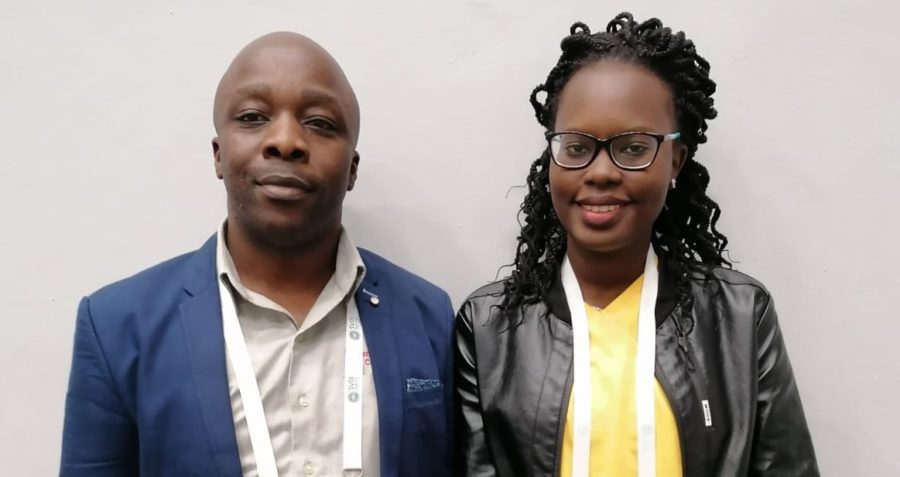Breaking the silence on gender-based violence in Uganda
 © Marina Schkot for Frontline AIDS
© Marina Schkot for Frontline AIDS
Following their participation in the Sexual Violence Research Initiative Forum in South Africa, Gracias Atwiine (PITCH country focal point in Uganda) and Rio Babirye (Ugandan Network of People living with HIV/AIDS (UNYPA), a PITCH partner), reflect on why we cannot ignore gender-based violence in the efforts to tackle HIV.
1. Why do you think it is important to work on GBV?
Rio: Because it is a symptom of HIV. GBV can cause HIV or vice-versa. As a young woman it is not safe to walk in the streets at night. When a woman is raped, they think she has caused the rape. Authorities need to strengthen their system. If a woman goes to a [police] station, the first thing they need to do is provide health services, or treatment and then go arrest the men. Some people think that when a man beats you, that means he loves you a lot. GBV is not a good thing. But it is widespread. It is a normalised behaviour. Sometimes young women are pregnant and are beaten up and lose their babies, some women end up dying.
Most of the time violence doesn’t come from strangers but within couples. In serodiscordant couples [when only one partner is living with HIV] women can experience violence. HIV test disclosure can lead to violence. Lots of young people living with HIV live with foster families and they experience violence from them and their communities. A lot of sensitisation needs to be done.
2. How does gender-based violence affect the communities you work with?
Gracias: GBV further sends key populations [men who have sex with men, people who use drugs, sex workers and transgender people] into hiding. This impacts on their health seeking behaviours. There are pockets of violence in the community. For example, there was an incident concerning a lesbian who was beaten by a doctor because the doctor suspected she was going out with his daughter . He was beating her up in the consultation room calling her a ‘wasted girl’ who is promoting homosexuality.
Otherwise, it’s okay for us to talk about LGBTIQ+ issues in Uganda, only that one has to be a little careful of the space because some Ugandans are really homophobic. However, it should be noted that a good number of policy makers and some few politicians understand key population issues because of the awareness and sensitisation meetings. We need to continue targeting the homophobic legislators and policy makers including the larger Ugandan society and religious leaders who think homosexuality is a western practice that can be un-learned through criminalisation.
Rio: If a young unmarried girl gets pregnant, she is either forced out of the community; suffers deadly violence because some people believe she is bringing shame to their families; or she is forced to marry the man that got her pregnant. It’s not going to be an easy process to change people’s minds in the communities – their cultural leaders are treated like gods. People who are changing their minds will not be accepted in the community because they are seen as sinners, as going against the rules. In our community we have tradition which is different from religion.
It is common in the North of Uganda that if a person is living with HIV, a traditional leader might provide a mix of milk and blood. The belief is that if that person drinks the beverage, they will be ‘healed’. But many people are dying because they do not take their HIV medication.
3. What are the experiences of violence amongst people living with HIV?
Rio: It’s an African tradition that if that girl does not explain that she was born with it [with HIV], they think they got it from sleeping from man to man. In some clinics in Uganda, girls were being sterilised when they go for family planning. Also, in some rural areas, girls who have HIV will be put on family planning, even if they did not want to. Even in Kampala, when people who are told that someone has HIV, they still have some questions. They think that people living with HIV is a different creature asking: how do they get it? How does their blood work?
4. How will you continue to address GBV in Uganda?
Gracias: We are going to mobilise as PITCH partners to mark the 16 Days of Activism against Gender-Based Violence including commemorating World AIDS Day. We intend to do a PhotoVoice gallery and invite policy makers for a dialogue and Photovoice exhibition. Focusing on the issues facing transgender women especially since they are not mentioned in National Policy guidelines and National HIV Prevention Plan. We want to highlight the plight of transgender persons, women who use drugs and male and female sex workers.
Rio: One of the ways is to engage with faith leaders through the Y+ ‘beauty pageant’ where they join community discussions about the effect of stigma and discrimination against young people living with HIV. The contestants represent fellow young people living with HIV and the 18 winners attend a national bootcamp. At this year’s grand finale in November we are inviting representatives from UN Women, Uganda Network on Law Ethics and HIV/AIDS (UGANET), International Community of Women living with HIV/AIDS (ICW) and others working on GBV and HIV, and parliamentarians to ask them questions. What are they doing to end GBV among young people living with HIV and in general? What is happening in the communities? We need to empower all the adolescent girls and young women.
The Partnership to Inspire, Transform and Connect the HIV response (PITCH) is a joint partnership between Frontline AIDS, Aidsfonds and the Dutch Ministry of Foreign Affairs.
Tags
Gender-based violenceHIV preventionLGBTPITCHUganda


